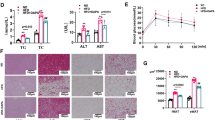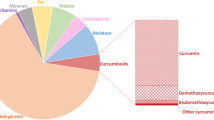Abstract
Acorn (Quercus acutissima CARR.) is a nut from the Fagaceae family that has been used in traditional medicine for many years. However, shells from acorns are regarded as a by-product and are mostly discarded. Anti-adipogenic activities of acorn shells were investigated using 3T3-L1 cells and methanol shell extracts (AE-M). AE-M demonstrated Cu2+-chelation activities and anti-oxidant activities via reduction of oxidative stress levels induced using AAPH. Six days after adipocyte differentiation, 50 and 100 μg/mL AE-M completely suppressed 3T3-L1 adipogenesis and the anti-adipogenic effect was stronger than for the positive control 50 μM quercetin. Treatment with AE-M in 3T3-L1 cells reduced mRNA expression levels of adipogenic genes. AE-M-inhibition was found in pre-adipogenic, early, and intermediate stages of adipogenesis in 3T3-L1 cells. The Wnt/β-catenin signaling pathway is required for AE-M-inhibition of 3T3-L1 adipogenesis.
Similar content being viewed by others
References
Barness LA, Opitz JM, Gilbert-Barness E. Obesity: Genetic, molecular, and environmental aspects. Am. J. Med. Genet. A 143A: 3016–3034 (2007)
Noh JR, Kim YH, Hwang JH, Gang GT, Yeo SH, Kim KS, Oh WK, Ly SY, Lee IK, Lee Ch. Scoparone inhibits adipocyte differentiation through down-regulation of peroxisome proliferators-activated receptor ? in 3T3-L1 preadipocytes. Food Chem. 141: 723–730 (2013)
Rosen ED, Hsu CH, Wang XZ, Sakai S, Freeman MW, Gonzalez FJ, Spiegelman BM. CEBPa induces adipogenesis through PPAR?: A unified pathway. Gene. Dev. 16: 22–26 (2002)
Niemela S, Miettinen S, Sarkanen JR, Ashammakhi N. Adipose tissue and adipocyte differentiation: Molecular and cellular aspects and tissue engineering applications. Vol. IV, pp. 1-16. In: Topics in Tissue Engineering. Ashammakhi N, Reis R, Chiellini F (eds). Biomaterials and Tissue Engineering Group, Oulu, Finland (2008)
Lee YJ, Han OT, Choi HS, Lee BY, Chung HJ, Lee OH. Antioxidant and antiadipogenic effects of PineXol. Korean J. Food Sci. Technol. 45: 97–103 (2013)
Lee OH, Kwon YI, Hong HD, Park CS, Lee BY, Kim YC. Production of reactive oxygen species and changes in antioxidant enzyme activities during differentiation of 3T3-L1 adipocytes. Appl. Biol. Chem. 52: 70–75 (2009)
Popovic BM, Stajner D, Zdero R, Orlovic S, Galic Z. Antioxidant characterization of oak extracts combining spectrophotometric assays and chemometrics. Sci. World J. Article ID 134656 (2013)
Rakic S, Petrovic S, Kukic J, Jadranin M, Tesevic V, Povrenovic D, Siler-Marinkovic S. Influence of thermal treatment on phenolic compounds and antioxidant properties of oak acorns from Serbia. Food Chem. 104: 830–834 (2007)
Moon HR, Chung MJ, Park JW, Cho SM, Cho DJ, Kim SM, Chun MH, Kim IB, Kim SO, Jang SJ, Park YI. Antiasthma effects through anti-inflammatory action of acorn (Quercus acutissma CARR.) in vitro and in vivo. J. Food Biochem. 37: 108–118 (2013)
Yook GJ, Lee HJ, Kim MK. Effect of chestnut and acorn on lipid metabolism, antioxidative capacity and antithrombotic capacity in rats. J. Nutr. Health 35: 171–182 (2002)
Sung IS, Kim MJ, Cho SY. Effect of Quercuse acutissima Carruthers extracts on the lipid metabolism. J. Korean Soc. Food Sci. Nutr. 26: 327–333 (1997)
Rahnama S, Rabiei Z, Alibabaei Z, Mokhtari S, Rafieian-kopaei M, Deris F. Antiamnesic activity of Citrus aurantium flowers extract against scopolamineinduced memory impairments in rats. Neurol. Sci. 36: 553–560 (2015)
Rakic S, Povrenovic D, Tesevic V, Simic M, Maletic R. Oak acorn, polyphenols and antioxidant activity in functional food. J. Food Eng. 74: 416–423 (2006)
Karimi A, Moradi MT. Total phenolic compounds and in vitro antioxidant potential of crude methanol extract and the correspond fractions of Quercus brantii L. acorn. J. HerbMed. Pharmacol. 4: 35–39 (2015)
Lee MH, Jeong JH, Oh MJ. Antioxidative activity of gallic acid in acorn extract. J. Korean Soc. Food Nutr. 21: 693–700 (1992)
Kang MH, Lee JH, Lee JS, Kim JH, Chung HK. Effects of acorn supplementation on lipid profiles and antioxidant enzyme activities in high fat diet-induced obese rats. J. Nutr. Health 37: 169–175 (2004)
Hsu CL, Huang SL, Yen GC. Inhibitory effect of phenolic acids on the proliferation of 3T3-L1 preadipocytes in relation to their antioxidant activity. J. Agr. Food Chem. 54: 4191–4197 (2006)
Hsu CL, Lo WH, Yen GC. Gallic acid induces apoptosis in 3T3-L1 pre-adipocytes via a Fas-and mitochondrial-mediated pathway. J. Agr. Food Chem. 55: 7359–7365 (2007)
White UA, Stephens JM. Transcriptional factors that promote formation of white adipose tissue. Mol. Cell. Endocrinol. 318: 10–14 (2010)
Ross SE, Hemati N, Longo KA, Bennett CN, Lucas PC, Erickson RL, Mac Dougald OA. Inhibition of adipogenesis by Wnt signaling. Science 289: 950–953 (2000)
Yun JW. Possible anti-obesity therapeutics from nature. Phytochemistry 71: 1625–1641 (2010)
Jung CH, Ahn JA, Heo SH, Ha TY. Eleutheroside E, and active compound from Eleutherococcus senticosus, regulates adipogenesis in 3T3-L1 cells. Food Sci. Biotechnol. 23: 889–893 (2014)
Kim MJ, Kim HK. Perilla leaf extract inhibits 3T3-L1 preadipocytes differentiation. Food Sci. Biotechnol. 18: 928–931 (2009)
Park HJ, Chung BY, Lee MK, Song YN, Lee SS, Chu GM, Kang SN, Song YM, Kim GS, Cho JH. Centipede graßs exerts antiadipogenic activity through inhibition of C/EBP, C/EBPa, and PPAR? expression and the AKT signaling pathway in 3T3-L1 adipocytes. BMC Complem. Altern. M. 12: 230–238 (2012)
Jeong YS, Jung HK, Cho KH, Youn KS, Hong JH. Anti-obesity effect of grape skin extract inf 3T3-L1 adipocytes. Food Sci. Biotechnol. 20: 635–642 (2011)
Harp JB. New insights into inhibitors of adipogenesis. Curr. Opin. Lipidol. 15: 303–307 (2004)
Gregoire FM, Smas CM, Sul HS. Understanding adipocyte differentiation. Physiol. Rev. 78: 783–809 (1998)
Kim HJ, Hiraishi A, Tsuchiya K, Sakamoto K. (-) Epigallocatechin gallate suppresses the differentiation of 3T3-L1 preadipocytes through transcription factors FoxO1 and SREBP1c. Cytotechnology 62: 245–255 (2010)
Nusse R, Varmus H. Three decades of Wnts: A personal perspective on how a scientific field developed. EMBO J. 31: 2670–2684 (2012)
Choi OM, Cho YH, Choi S, Lee SH, Seo SH, Kim HY, Han G, Min DS, Park T, Choi KY. The small molecule indirubin-3’oxime activates Wnt/ß-catenin signaling and inhibits adipocyte differentiation and obesity. Int. J. Obesity 38: 1044–1052 (2014)
Fujino T, Asaba H, Kang MJ, Kang Y, Ikeda Y, Sone H, Takada S, Kim DH, Ioka RX, Ono M, Tomoyori H, Okubo M, Murase T, Kamataki A, Yamamoto J, Magoori K, Takahashi S, Miyamoto Y, Oishi H, Nose M, Okazaki M, Usui S, Imaizumi K, Yanagisawa M, Sakai J, Yamamoto TT. Low-density lipoprotein receptorrelated protein 5 (LRP5) is essential for normal cholesterol metabolism and glucose-induced insulin secretion. Proc. Natl. Acad. Sci. USA 100: 229–234 (2003)
Kanazawa A, Tsukada S, Kamiyama M, Yanagimoto T, Nakajima M, Maeda S. Wnt5b partially inhibits canonical Wnt/ß-catenin signaling pathway and promotes adipogenesis in 3T3-L1 preadipocytes. Biochem. Bioph. Res. Co. 330: 505–510 (2005)
Kim MB, Song YW Kim CH, Hwang JK. Kirenol inhibits adipogenesis through activation of the Wnt/ß-catenin signaling pathway in 3T3-L1 adipocytes. Biochem. Bioph. Res. Co. 445: 433–438 (2014)
Author information
Authors and Affiliations
Corresponding author
Rights and permissions
About this article
Cite this article
Shon, MS., Kim, SK., Song, JH. et al. Anti-oxidant and anti-adipogenic effects of acorn (Quercus acutissima CARR.) shell extracts via regulation of wnt signaling in 3T3-L1 cells. Food Sci Biotechnol 25, 875–882 (2016). https://doi.org/10.1007/s10068-016-0144-1
Received:
Revised:
Accepted:
Published:
Issue Date:
DOI: https://doi.org/10.1007/s10068-016-0144-1




